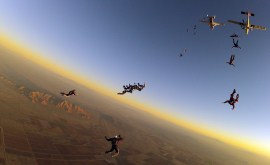
Parachutes are a critical technology used by the military in delivering personnel and cargo supplies. The United States formed its first parachute test platoon of airborne infantry in the 1940’s. Since then parachuting technology has continually advanced as well as the way in which paratroopers jump from an aircraft. There are a few basic types of military jumps.
The first is a static line or low level, low opening jump. Also referred to as LALO, these types of jumps offer the advantage that a large number of troops can be quickly dropped into an area, but because of the low altitude it is one of the more dangerous jumps to execute. The static line refers to the mechanism in which this type of jump is carried out. The parachute ripcord is attached to a cable running along the inside of the aircraft and unravels when the jump has been made. The weight of the paratrooper pulls against the line after they have jumped and pulls the parachute from the deployment bag. The paratroopers weight will also break the smaller cord once the chute has been opened, allowing the jumper to separated from the static line. Static line jumps ideally mean the parachute will automatically open, eliminating the need for human interference.
A second type of jump is the high altitude, low opening jump or HALO. HALO jumps are used when the aircraft and jumpers need to stay undetected. Accuracy is extremely important in this type of jump, as the paratroopers are deployed at a very low altitude. During a HALO jump, the paratrooper will free fall at a high speed towards the landing zone. They will deploy the parachute close to the ground allowing for minimal exposure possible. A drawback to the HALO jump is that because the aircraft must fly closer to the landing zone, it may be more vulnerable to attack.
The third type of jump is the high altitude, high opening jump or HAHO. This type of jump is used when an aircraft cannot fly over a landing zone or if the noise of the parachute would alert an enemy. Paratroopers will deploy their parachutes at very high altitudes and glide into a landing zone at a horizontal distance. They will often glide for a considerable distance in the air. This technique allows for minimal detection by an opposing force.
A concern with both HALO and HAHO jumps is the possibility of hypoxia. Hypoxia is caused from oxygen deprivation. As a result, supplemental oxygen and safety procedures are required during these operations.

